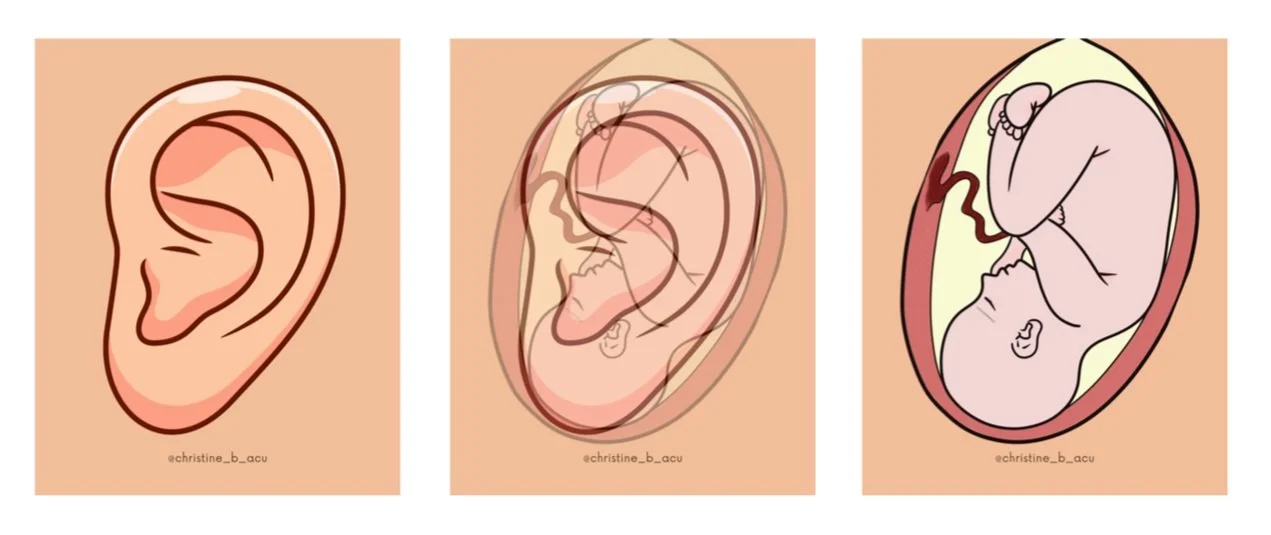The Healing Power of the Ear: Understanding the NADA Protocol and Auricular Acupuncture
If you are a regular client of mine, you have had auricular acupuncture!
If you are new to this blog and my practice: —yes, acupuncture on the ear—is a fascinating and effective system that maps the entire body onto this small but mighty body part. If you look closely, the ear resembles an upside-down baby in the fetal position. The lobe represents the head, the upper curve (helix) traces the spine, and the inner hollow (concha) holds internal organs like the heart, liver, and lungs. This map allows practitioners to treat the whole body by targeting precise points on the ear.
The ear resembles an upside-down baby in the fetal position.
Ear acupuncture has roots in Traditional Chinese Medicine and was further developed in modern times by French physician Dr. Paul Nogier in the 1950s. It’s used all over the world today to treat everything from chronic pain and anxiety to addiction and trauma.
What Is the NADA Protocol?
The NADA Protocol (developed by the National Acupuncture Detoxification Association) is a simple, standardized set of five ear points: Shen Men, Sympathetic, Kidney, Liver, and Lung. It’s typically done with very fine, sterile needles placed on both ears, while the person rests quietly for 30–45 minutes. The experience is calming, grounding, and often emotionally supportive—even if words aren’t spoken.
This protocol is used as an adjunct treatment in addiction recovery programs, mental health clinics, and disaster-relief settings. It doesn’t replace therapy or other support systems, but it enhances a person’s capacity to regulate emotions, manage cravings, and feel more at home in their body. So it is a great addition to talk therapy and hypnosis.
How It Helps with Addiction
NADA is commonly used to support recovery from:
Alcohol dependency
Opiate and opioid use
Nicotine addiction (smoking cessation)
Cannabis or stimulant overuse
Prescription medication dependency
People often report reduced withdrawal symptoms, fewer cravings, improved sleep, and a greater sense of calm. The real success comes when someone is ready to change. That readiness is the foundation. Ear acupuncture can then become an incredible ally in the process.
Smoking Cessation & Craving Control
For those trying to quit smoking, auricular acupuncture (especially lung and Shen Men points) can dramatically ease irritability, tension, and that twitchy sense of needing “just one more.” It’s been used in smoking cessation clinics around the world because it works with the body’s nervous system to support detox and calm.
Battlefield Acupuncture & Military Use
In high-pressure, high-stress environments like the military, simplicity and speed matter. That’s where Battlefield Acupuncture comes in—a modified protocol created by U.S. Air Force physician Dr. Richard Niemtzow. It uses a handful of points on the ear to deliver rapid pain relief with tiny semi-permanent needles that can stay in for several days.
Battlefield Acupuncture is now used across military hospitals and VA clinics for physical pain, trauma and PTSD symptoms. Veterans report feeling more stable, less reactive, and more able to sleep and regulate emotion.
Ear Acupuncture for PTSD and Emotional Trauma
Beyond addiction and physical pain, ear acupuncture has found a major role in trauma care. The NADA protocol is widely used for PTSD—in the military, in refugee camps, and in disaster response efforts (such as after 9/11 and Hurricane Katrina). It’s gentle, non-verbal, and works well even when someone doesn’t feel ready to talk.
The five-point protocol targets the nervous system’s stress response, helps regulate the adrenal system, and brings down hypervigilance and overwhelm. Veterans, first responders, and survivors of all kinds have benefited from the deep, quiet reset this treatment offers.
A Great Fit for Groups
One of the most beautiful aspects of ear acupuncture is that it can be administered in a group setting. Picture a calm room, soft music, chairs arranged in a circle, and people quietly receiving treatment side by side. There’s something deeply human and healing about being with others in silence—especially when working through pain, trauma, or change.
Group settings are cost-effective, accessible, and surprisingly powerful. They allow communities to heal together, without the pressure of one-on-one talking or needing to explain everything.
A Tool for Change—If You’re Ready
No tool works if you’re not ready. Whether you’re trying to quit smoking, get off substances, or find stability after trauma, readiness is key. But when that moment comes—when you know something has to shift—ear acupuncture can meet you there.
It supports you holistically (body, mind and spirit) so you can make the changes you’re striving for. It brings a little more calm, a little more focus, and a lot more resilience.
Ready to Try It?
If you're curious about how ear acupuncture could support you—whether for stress, cravings, sleep, or emotional grounding—I’d love to meet you. This gentle, non-invasive treatment is a powerful tool for deep healing.
Book your first session today—and take that first step toward feeling more like yourself again.



